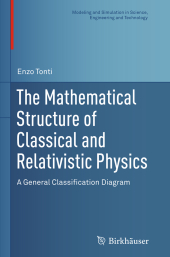 Neuerscheinungen 2016Stand: 2020-02-01 |
Schnellsuche
ISBN/Stichwort/Autor
|
Herderstraße 10
10625 Berlin
Tel.: 030 315 714 16
Fax 030 315 714 14
info@buchspektrum.de |

Enzo Tonti
The Mathematical Structure of Classical and Relativistic Physics
A General Classification Diagram
Softcover reprint of the original 1st ed. 2013. 2016. xxxvi, 514 S. 164 Farbabb., 175 Tabellen. 235 mm.
Verlag/Jahr: SPRINGER, BERLIN; SPRINGER NEW YORK; BIRKHÄUSER 2016
ISBN: 1-493-94232-8 (1493942328)
Neue ISBN: 978-1-493-94232-9 (9781493942329)
Preis und Lieferzeit: Bitte klicken
The theories describing seemingly unrelated areas of physics have surprising analogies that have aroused the curiosity of scientists and motivated efforts to identify reasons for their existence. Comparative study of physical theories has revealed the presence of a common topological and geometric structure. The Mathematical Structure of Classical and Relativistic Physics is the first book to analyze this structure in depth, thereby exposing the relationship between (a) global physical variables and (b) space and time elements such as points, lines, surfaces, instants, and intervals. Combining this relationship with the inner and outer orientation of space and time allows one to construct a classification diagram for variables, equations, and other theoretical characteristics.
The book is divided into three parts. The first introduces the framework for the above-mentioned classification, methodically developing a geometric and topological formulation applicable to all physical laws and properties; the second applies this formulation to a detailed study of particle dynamics, electromagnetism, deformable solids, fluid dynamics, heat conduction, and gravitation. The third part further analyses the general structure of the classification diagram for variables and equations of physical theories.
Suitable for a diverse audience of physicists, engineers, and mathematicians, The Mathematical Structure of Classical and Relativistic Physics offers a valuable resource for studying the physical world. Written at a level accessible to graduate and advanced undergraduate students in mathematical physics, the book can be used as a research monograph across various areas of physics, engineering and mathematics, and as a supplemental text for a broad range of upper-level scientific coursework.
1 Introduction.- Part I Analysis of variables and equations.- 2 Terminology revisited.- 3 Space and time elements and their orientation.- 4 Cell complexes.- 5 Analysis of physical variables.- 6 Analysis of physical equations.- 7 Algebraic topology.- 8 The birth of the classification diagrams.- Part II Analysis of physical theories.- 9 Particle dynamics.- 10 Electromagnetism.- 11 Mechanics of deformable solids.- 12 Mechanics of fluids.- 13 Other physical theories.- Part III Advanced analysis.- 14 General structure of the diagrams.- 15 The mathematical structure.- Part IV Appendices.- A Affine vector fields.- B Tensorial notation.- C On observable quantities.- D History of the diagram.- D.1 Historical remarks.- E List of physical variables.- F List of symbols used in this book.- G List of diagrams.- References.
From the book reviews:
"The author studies the mathematical structure of classical and relativistic physics with a non-standard approach. ... the books can be highly recommended for readers from mathematics, physics and engineering, in particular for readers looking for an alternative approach to classical and relativistic physics." (Willi-Hans Steeb, zbMATH, Vol. 1298, 2014)


